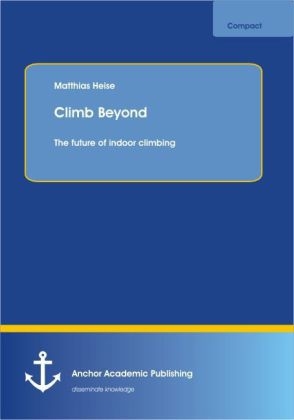
Climb Beyond: The future of indoor climbing
Anchor Academic Publishing (Verlag)
978-3-95489-199-3 (ISBN)
Text Sample:
Chapter 3., Description of specific characteristics: Climb Beyond combines state-of-the art technology to give users the real climbing experience. It helps people to enjoy climbing and facing their fear. It helps them to advance faster while saving money on instruction courses because they might not need the advanced courses anymore. Without our service, anyone who starts climbing will experience kind of a logarithmic learning curve. But for urbanized people a faster increase is of high interest. Therefore our service will increase the learning curve much faster in no time.
The service is easy to use, available all the time and does not cost tons of money. Extended services for accessing the tracked data allow anyone to review their own capabilities even at home. Because all the technology is put into a single small device, we can enhance any existing climbing facility by just installing the device and calibrating it to environmental conditions (point of view, light and shadow). There is no need to change anything else in the facility itself. Just the device and an Internet connection is required.
Body and movement tracking:
Body recognition is a huge topic in the gaming industry. Devices like Nintendo® Wii and Sony® Eye-Toy allow players to use their body to interact freely with the game. But the real break-through was done by Microsoft® with Kinect for XBox360 because it really tracks one to 4 bodies (including skeleton data) at the same time and no additional technical equipment has to be held by the player. Kinect is the first device that has a computing power that is high enough and a latency low enough to give the player a smooth feeling of real interaction. Ten years ago this would have been like magic but nowadays every teenager knows about that topic and feels comfortable using this technology.
These technologies are of interest for indoor climbing because they allow detailed tracking of a human body. Within indoor climbing any device that does not need to be worn on the body has a clear advantage. Therefore only Microsoft® Kinect is of interest. But so far Microsoft® did not publish any commercial license and the device only works up to a distance of 3.5 meters. Typically distances in indoor climbing facilities are 3 to 10 meters. This is why a different method of using two cameras in a stereoscopic mode will be used. Tracking data includes:
- Video recording for later playback and teaching.
- Distance information for terrain recognition and determining the distance of the climber between the camera device and to climbing wall.
- Shape recognition of any human body for compressed data storage and laser re-projection.
The advantages of these tracking methods are:
- re-usage of existing technology: Stereoscopic or cameras with depth/distance recognition are on the market.
- re-usage of existing algorithms from the scientific field of computer graphics.
- full body recognition: a complete human body is tracked and not only hands or feet.
- no additional equipment:
- people do not need to buy any new equipment.
- people do not need to wear anything on your body.
- no markers to put on hands (as used in motion capturing in film industry).
Body projection:
The tracked data can easily be used for later review or teaching but the real advantage is the re-projection of the already tracked data of a professional climber onto the climbing wall to help any less experienced climber to advance and feel more secure. Projection can be done while climbing so that the next move from the current position is projected or to allow a step-by-step view to learn about the route while still standing on the ground.
| Erscheint lt. Verlag | 17.1.2014 |
|---|---|
| Sprache | englisch |
| Maße | 155 x 220 mm |
| Gewicht | 75 g |
| Themenwelt | Sozialwissenschaften ► Soziologie ► Allgemeine Soziologie |
| ISBN-10 | 3-95489-199-9 / 3954891999 |
| ISBN-13 | 978-3-95489-199-3 / 9783954891993 |
| Zustand | Neuware |
| Haben Sie eine Frage zum Produkt? |
aus dem Bereich


